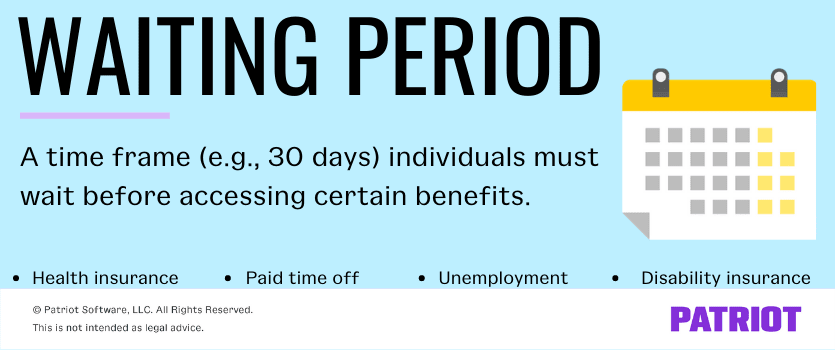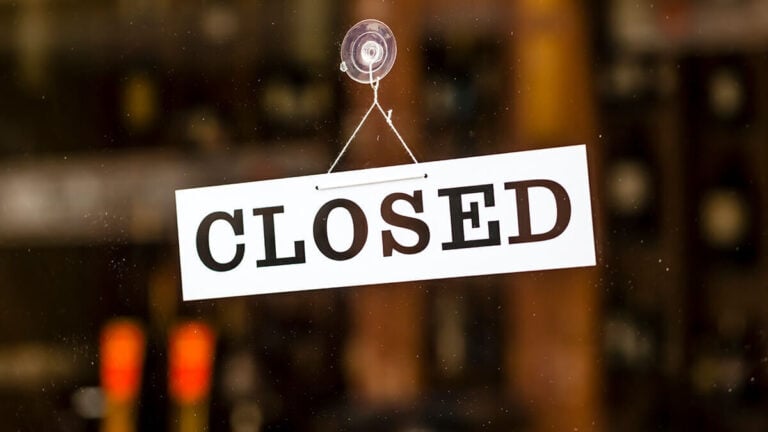Businesses, insurance companies, and the government all use waiting periods. If you provide company-sponsored benefits to employees, you might decide to set a waiting period. So, what is it?
Read on to learn what is an employee waiting period, rules for setting the time frame, and how to implement one in your small business.
What is a waiting period?
A waiting period is a time frame individuals must wait before accessing company, insurance, or unemployment benefits. You may also hear it referred to as a qualifying period or, in the case of a waiting period for health insurance claims, an elimination period. Many businesses set one for new hires to lower employee turnover.

So, should you use a qualifying period in your small business? Using one gives you more time between onboarding an employee and doling out company-sponsored benefits, like health insurance or paid time off (PTO). And if you have a history of high turnover rates, especially with new hires, you might opt to use one.
However, the choice is yours. Some employers choose to use no waiting period for the employee benefits package.
Types of benefits a qualifying period could apply to
There are several benefits that use a waiting period. And again, employers don’t set all of them. But even if you’re not the one in charge of it, you may need to pass on the information to your employees.
Here are a few company, insurance, and government benefits that commonly use a qualifying period:
- Health insurance
- PTO
- Unemployment
- Disability
Health insurance
Both employers and insurance companies can set waiting periods.
Employers might make employees wait a certain period of time after their hire date before becoming eligible to sign up for health insurance coverage.
For example, you could set a:
- 30-day waiting period for health insurance
- 60-day waiting period for health insurance
- 90-day insurance waiting period for new hires
Health insurance companies may set an additional elimination period before policy holders (i.e., your employees) can make a claim and receive benefits. Of course, there is health insurance without waiting period.
If you offer a group health plan to your team, you need to know about some IRS rules. The waiting period for small business health insurance from employers cannot exceed 90 days. Keep the 90-day waiting period maximum in mind when coming up with your insurance eligibility terms.
PTO
Paid time off is when an employee receives their regular wages when they take off from work. If you have a paid time off policy, your waiting period can apply to the following:
- The time before an employee can accrue PTO
- The time before an employee can use PTO
- Both of the above
PTO accrual is when an employee receives (or accrues) paid time off hours as they work. You can calculate accruals based on the number of hours, days, or even weeks worked (e.g., one hour of PTO per 40 hours worked).
If you set a waiting period for PTO accrual, usage, or both, specify it in your employee handbook. For example, you could say something like:
- Employees accrue one hour of PTO per every 40 hours worked, after 30 days.
- Employees can use accrued PTO after 90 days.
Unemployment
As an employer, you’re responsible for paying federal and state unemployment taxes on behalf of your employees.
By paying into the unemployment pot, your employee may become eligible for unemployment benefits if they’re laid off through no fault of their own.
State governments are the ones that regulate unemployment claims and benefits. But because you need to give employees unemployment information during the layoff process, you should understand how it works.
Like PTO and health insurance, the unemployment system uses a qualifying period. This means workers must wait a certain period of time after losing their jobs before becoming eligible for unemployment benefits.
Unemployment waiting periods vary by state. However, many states use a two-week time period for benefits. In some cases, like when there is a state of emergency (e.g., COVID-19), the state might waive the qualifying period for unemployment benefits.
Disability
If you offer short- or long-term disability insurance to your employees, you generally set up a plan through an insurance company.
However, there are some states that give you the option to pursue a state disability insurance plan (e.g., New Jersey). Under a state plan, employees receive benefits through the state government.
Whether you have disability insurance through a private provider or your state, employees typically have to go through a waiting period. The disability insurance waiting period can range from 30 days – 720 days. The lower the elimination period, the higher the premium.
Although disability benefits either come from the insurance company or state, you need to know about the waiting periods for a couple of reasons:
- Choosing a plan that doesn’t break your business budget
- Letting employees know about their disability benefits
Using a waiting period? Here’s what to do
Want to add a waiting period to company-sponsored benefits? Or, do you need to communicate insurance elimination periods to your team? Take a look at these three steps to get started.
1. Do your research
Before setting a waiting period or purchasing a plan with one, do some research.
If you’re the one choosing the waiting period, be mindful of industry standards and rules (e.g., IRS 90-day maximum period).
And if you’re choosing between plans (e.g., health or disability insurance), pay attention to how waiting periods influence pricing.
2. Communicate with employees
If you have a waiting period for company benefits, let your employees know. And, make sure employees understand qualifying periods associated with things like unemployment benefits and disability coverage.
Provide employees with information about waiting periods when they start working. If you have to lay off an employee, communicate unemployment waiting periods to them.
3. Add it to your employee handbook
Include everything employee-related in your employee handbook. That way, your team has someplace to reference information.
Specify things like:
- What is a qualifying period
- Which benefits have one
- Time frame
And, keep records indicating when the employee’s waiting period starts and ends per benefit.
Looking for a better way to keep your employee data organized? Patriot’s HR software add-on could be just what you’re searching for. Try it as an add-on to our award-winning payroll today, and get a free trial of both!
This is not intended as legal advice; for more information, please click here.





